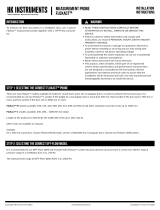
Table of contents
1. Safety instructions .................................................................................................................................................. 5
1.1 Warnings .......................................................................................................................................................... 5
1.2 Environment protection .................................................................................................................................... 5
1.3 Symbols used ................................................................................................................................................... 5
2. Conformity and standard ....................................................................................................................................... 6
2.1 FCC rules ......................................................................................................................................................... 6
2.2 Canadian standard ........................................................................................................................................... 6
3. Introduction ........................................................................................................................................................... 7
3.1 Description of the transmitter ........................................................................................................................... 7
3.1.1 Overall description .................................................................................................................................... 7
3.1.2 Screen description .................................................................................................................................... 7
3.2 Connections ..................................................................................................................................................... 8
4. Mounting ............................................................................................................................................................... 9
5. Electrical connections ........................................................................................................................................... 10
6. First Start-up ........................................................................................................................................................ 11
6.1 Set the transmitter ......................................................................................................................................... 11
6.2 Connect a probe............................................................................................................................................. 11
6.3 Set a channel ................................................................................................................................................. 12
6.4 Set an output ................................................................................................................................................. 12
6.5 Disconnect a probe ......................................................................................................................................... 13
7. Transmitter features .............................................................................................................................................14
7.1 General features ............................................................................................................................................. 14
7.2 Features of the housing .................................................................................................................................. 14
7.3 Dimensions .................................................................................................................................................... 15
7.4 Possible optional measurements ..................................................................................................................... 15
8. Set the transmitter ............................................................................................................................................... 16
8.1 Set the language ............................................................................................................................................ 16
8.2 Set the country ............................................................................................................................................... 16
8.3 Set the date, time zone and time .................................................................................................................... 16
8.4 Set the brightness .......................................................................................................................................... 16
9. Set inputs and outputs ......................................................................................................................................... 17
9.1 Set the measurement channels ....................................................................................................................... 17
9.2 Set the outputs ............................................................................................................................................... 17
9.2.1 Set the analog outputs ........................................................................................................................... 17
9.2.2 Perform an output diagnostic .................................................................................................................. 18
9.2.3 Set the digital output (Modbus RTU) ....................................................................................................... 19
9.3 Set the probes and the pressure module ......................................................................................................... 19
9.3.1 Normative values .................................................................................................................................... 19
9.3.2 Congure the compensation of a CO2 or hygrometry probe ..................................................................... 19
9.3.3 Congure the differential pressure module .............................................................................................. 20
9.4 Set the alarms ................................................................................................................................................ 22
9.4.1 Set the alarm thresholds ......................................................................................................................... 22
9.4.2 Set the alarms parameters ...................................................................................................................... 22
9.5 Set the autozero ............................................................................................................................................. 23
10. Security and connectivity ................................................................................................................................... 24
10.1 Wireless communication ............................................................................................................................... 24
10.2 Dene the security code ............................................................................................................................... 24
10.3 Dene the Touch Lock functionality ............................................................................................................... 24
10.4 Reset instrument from factory ....................................................................................................................... 24
11. Information about transmitter, probes and module ............................................................................................ 26
11.1 Instrument, probes and module information .................................................................................................. 26





















